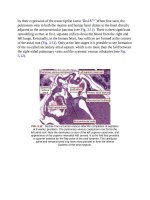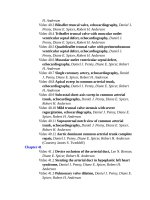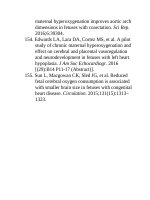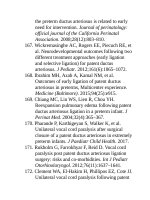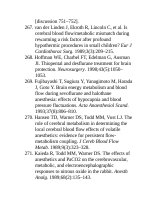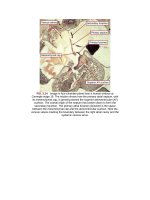Andersons pediatric cardiology 1897
Bạn đang xem bản rút gọn của tài liệu. Xem và tải ngay bản đầy đủ của tài liệu tại đây (148.93 KB, 3 trang )
changesbetweenscheduledclinicvisitsandprovideanopportunityfor
identifyingproblemsbeforeseriousdeterioration.47Useofweb-based
telemedicinehasbeenincorporatedintothemanagementofinterstageinfantsat
somecenters.Atabletordevicewithvideodisplayfunctionsprovidesthe
potentialbenefitofreal-timeobservationofphysicalstatuswithouttheneedfor
theinfantbeingtransportedtolocalmedicalproviderorcardiologyclinic
site.48,49
High-riskspecialtyclinicsduringtheinterstageperiodprovidecarecontinuity
acrossthephasesofinpatientandoutpatientcare.Theseinterstageclinicsideally
providemultidisciplinarycarethroughengagementofnutrition,speechtherapy,
socialwork,andpsychologyservicesinadditiontothecardiaccareteamat
weeklyorbiweeklyintervals.Proximitytothehigh-riskinterstageclinicmaybe
prohibitiveforsomepatientsandthusrequireclosercollaborationbetweenthe
referringcardiologistandtheinterstagecareteam.Insomecircumstances,
dischargetoatemporaryresidenceincloseproximitytothesurgicalsiteduring
theinterstageperiodispreferableduetotheremoteaccesstohealthcarefrom
thefamily'spermanentresidence.
ProgressionThroughStageIIPalliation
TimingofStageIIPalliation
ProgressiontothecavopulmonaryanastomosisatstageIIpalliationreducesboth
wallstressonthesinglesystemicventricle,mayreduceatrioventricularvalve
insufficiency,increasesdiastolicpressurewithimprovedcoronaryartery
perfusion,andleadstomoreefficientcirculation.Priortoinstitutionofhome
monitoring,timingofstageIIpalliationwasdelayeduntil6monthsofage.In
theinitialseriesofhome-monitoredpatients,thosewhobreachedhome
monitoringcriteriahadsuccessfulstageIIpalliationat3.6±1months,with
similarsomaticgrowthtothosepatientswhodidnotbreachhomemonitoring
criteriaandhadstageIIpalliationat5.6±2.1months.1
Thesuccessofearlycavopulmonaryanastomosisinthesepatientsdeemedat
greatestriskforinterstagemortalityhasmodifiedpracticeatsomecentersinthat
stageIIpalliationiselectivelyperformedat4monthsofageorearlierif
necessary.Shorteningtheperiodofrisklinkedtotheinefficientdual-distribution
circulationafterstageIpalliationwaspostulatedtoimprovesurvival.Datafrom
31centersparticipatingintheNPC-QICregistrydemonstratedlessinterstage
mortalityincentersthatperformedstageIIpalliationlessthan5months(5.7vs.
9.9months),withsimilarsurvivaltohospitaldischargeandhospitallengthof
stayfollowingstageIIpalliationbetweengroups.50TheCongenitalHeart
Surgeons’SocietyidentifiedthatoptimaltimingofstageIIpalliationdiffered
acrosspatientriskgroups.Specifically,low-andintermediate-riskpatientshad
similaroperativesurvivalwhenstageIIpalliationwasperformedat4,6,or8
months.However,stageIIpalliationat3monthsofagewasassociatedwith
maximal2-yearsurvival.YoungerageatstageIIpalliationforhigh-riskpatients
didnotexhibitasimilarsurvivaladvantagewithearliertimingofstageII
palliation.High-riskpatientswerethosewhohadmoderate-severerightventricle
dysfunctionjustpriortostageIIpalliation,requiredextracorporealmembrane
oxygenationafterstageIpalliation,andhadlowerweight-for-agez-scoreatthe
pre–stageIIpalliationcatheterization.51Similarfindingswerenotedinthe
PediatricHeartNetworkSingleVentricleReconstructionevaluationforoptimal
timingofstageIIpalliation.52Astrategythatusesinpatientmanagement
throughouttheinitialinterstageperiodforhigh-riskpatientsdoesnotmitigate
thegreatermortalitybeyondstageIIpalliationwhencomparedwiththose
patientsdeemedsuitableforhomemonitoringafterstageIpalliation(Fig.
72.7).3
FIG.72.7 Actuarialsurvivalforhome-monitoredpatientswithevents,
home-monitoredpatientswithoutevents,andinterstageinpatients.Survival
forinterstageinpatientsissignificantlylowerthanpatientsdischargedwith
homemonitoring.Survivalwassimilarforoutpatientswithandwithout
home-monitoredevents.CPB,Cardiopulmonarybypass;ECMO,
extracorporealmembraneoxygenation;S1P,stage1palliation;S2P,stage
2palliation.(FromRuddNA,FrommeltMA,TweddellJS,etal.Improving
interstagesurvivalafterNorwoodoperation:outcomesfrom10yearsof
homemonitoring.JThoracCardiovascSurg.2014;148[4]:1540–1547.)
